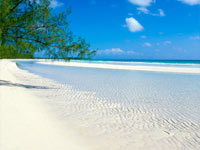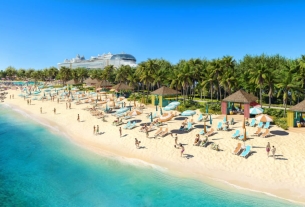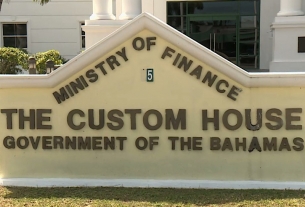 From the deck of Banana Bay restaurant on the south shore of Grand Bahama Island, where I waited for a plate of conch fritters, I admired the pretty but empty beach that stretched to the east: a narrow, curving strip of white sand; a shallow lagoon of clear blue water; a hammock strung between two wind-bent palms.
From the deck of Banana Bay restaurant on the south shore of Grand Bahama Island, where I waited for a plate of conch fritters, I admired the pretty but empty beach that stretched to the east: a narrow, curving strip of white sand; a shallow lagoon of clear blue water; a hammock strung between two wind-bent palms.
I turned to the west, sighting more sand, more palm trees, until a sign appeared in my camera’s viewfinder: “Nude beach. Swimsuits optional. Voyeurism prohibited. Absolutely no peering, staring, leering or outright gawking.”
I lowered my camera in a flash. What category would photography fall into – voyeurism or gawking? Had anyone seen me? I flicked my eyes up and down the beach, my gaze never stopping so I couldn’t be accused of staring, until I was sure that the few people walking along the sand were fully clothed. Then I raised my camera again and snapped a picture.
Beaches are the No. 1 reason tourists come to Grand Bahama, its tourism officials say, and I was on one of its prettiest, Fortune Bay, less than 10 miles from Freeport and just steps from Grand Bahama Highway.
Earlier, a nature tour had taken me to a more secluded spot, Gold Rock Beach, part of Lucayan National Park. The beach was accessible by a quarter-mile walk, mostly via boardwalk, through a mangrove swamp. When we emerged from the trees, half-tame raccoons met us, begging for food.
The beach was narrow, but a large sandbar was just a short walk away through shallow water clear enough that I could see the ripples in the sandy bottom. The tour guide said that scenes from Pirates of the Caribbean had been filmed here, and I wondered if cast, crew and equipment arrived by canoes or came through the mangroves each day.
There are beaches here for snorkeling and for fishing, undeveloped beaches with few if any amenities, beaches with bars, music and watercraft rentals, beaches for shelling, beaches with kayaking trails, and, as I’d just learned, at least one nude beach.
Despite Grand Bahama’s wealth of beaches, though, tourism – which in the late 1980s and early ’90s drew more than 1 million visitors a year – took a dive here years ago and is recovering very slowly. Last year, tourism drew only about 840,000 people, their numbers diminished by the ups and downs of the U.S. economy, competition from other budget beach destinations like Cancun, hurricane damage and aged hotels.
I had come to explore the island at the northwest edge of the Bahamas by way of a fast ferry from Port Everglades, a ride of 2 1/2 to 3 hours. Three months later I would return on the Bahamas Celebration, a low-budget “ferry” cruise that gives passengers the option of remaining on the ship for a traditional two-night cruise with a day visit to Freeport, or spending a few nights on the island before returning on the ship to the Port of Palm Beach.
The ferry, in operation for about 18 months, and the Bahamas Celebration, which began sailing from Palm Beach to Freeport three years ago, are part of that rebuilding. Carnival and Norwegian have added port calls as well, pushing total cruise ship arrivals from about 336,000 10 years ago to nearly 733,000 in 2012. However, cruise passengers who spend only part of a day on Grand Bahama account for the vast majority of those arrivals, while the number of far-more-lucrative overnight visitors has plummeted.
The Grand Bahama Port Authority has spiffed up the port in the last year, adding a straw market, Senor Frogs and other businesses, so some cruise passengers never even leave the port.
Other upgrades: More flights from the United States and Canada are being added, and the closed Reef village is being renovated and rebranded by Sunwing, which will add 500 hotel rooms. Grand Bahama had almost 3,000 rooms in 1995; today it has about 2,100.
A small eco-tourism element has been added, but green tourism can absorb only so many tourists and still remain green, said David Johnson, director-general at Bahamas Ministry of Tourism. “It’s a feature that helps to brand the island and we hope to see more of that but … ecotourism by its very nature is not a volume-driven experience.”
It would be my first Grand Bahamian adventure. But first, I had to get there.
THE FERRY
The Pinar del Tio is rolling side to side. The few people who are walking around grab a post or seat back, then lurch to the next pillar or seat. On my way to the snack bar, I miscalculate and let go of a seat back just as the ship rolls to one side, so I throw my arm around a pillar. Never mind, I don’t need coffee that badly.
It’s a windy, overcast Friday morning in January and the ferry is encountering rough seas. I bought a round-trip coach-class ticket to Grand Bahama Island, where I’ve reserved two nights in a hotel. Sunday night I’ll return on the ferry to Port Everglades; the ride will be smooth.
The Pinar del Rio has a small first-class seating area, a snack bar, a bar that’s not open this morning, slot machines, a duty-free shop, and a movie showing at the back of the ship. I’ve stowed my roll-aboard suitcase in a luggage area (it was free, but there’s a charge to check larger bags). The ferry holds 463 passengers; on this trip it looks like a third to half of the seats are empty.
Outside the ferry terminal, a fleet of taxi vans awaits. We’re divided into groups based on what hotel we’re going to. If the group is eight or more, the ride is only $5. Several vans quickly fill with people going to the Grand Lucayan or the Viva Wyndham Fortuna Beach. But I’ve chosen the Bell Channel Inn, a small, out-of-the-way hotel, and I split the $27 fare with the only other passenger going there.
I have a late lunch of crab salad by a window in the inn’s restaurant, which overlooks Bell Channel Bay. Then I spend some time with Jeanne, the hotel’s tour concierge.
Jeanne arranges for me to join a group tour of Lucayan National Forest the next day and promises to look into what’s available on Sunday. Because of the timing of the tours and the fact that many shops are closed on Sunday, I won’t be able to fit in kayaking or a visit to a shop that hosts rum-tastings. Next trip, I promise myself.
I set off on foot for Port Lucaya Marketplace, about a mile’s walk (and which, despite its name, is not located at the port). The marketplace is a 12-acre complex on the waterfront, painted Bahamian-style in bright colors and built around Count Basie Square, which has a bandstand with dancing to live music that I can hear faintly from my hotel balcony at night. It has a marina, straw market, boutiques, hair-braiding stations, restaurants and bars specializing in rum drinks.
Once, the International Bazaar in the center of Freeport was the hub of tourism activities. But since 2004, when the nearby Royal Oasis resort closed and hurricanes damaged the market, most of its shops and restaurants have closed or moved to Port Lucaya Marketplace, the new Tourism Central.
Most tours include a stop at the marketplace, so over the course of my two trips to Grand Bahama, I’ll end up here several times, where I eat lunch, drink rum runners, buy mango-flavored rum in a liquor shop, get a haircut, go across the street to gamble at the island’s only casino, take a boat tour and evade the entreaties of shop owners to come in and look.
Saturday morning, a bus picks me up at my hotel for the trip to Lucayan National Forest and Gold Rock Beach, about 25 miles east of Freeport on the island’s south shore. It’s a small forest, just over 40 acres, but it has six miles of underwater caves and tunnels, formed when acidic water ate through the limestone. The Arawak Indians, also called the Lucayans, inhabited the island before Christopher Columbus arrived on nearby San Salvador, and were subsequently wiped out by the Spanish. But before that, they used the cave system as burial grounds.
As our guide tells us about the Arawaks, he leads us along boardwalks, past palms, stands of pine trees, orchids, bromeliads and other tropical plants. We follow him down stairs into two caves that opened up when the ground above them partially collapsed.
The light is dim in the first cave; only portions of these caves are open to the sky. Bromeliads hang from broken rock ledges. Our guide points out bats clustered in corners, fish in the greenish water illuminated by angled rays of light and entrances to underwater tunnels that only certified cave divers are permitted to explore.
In the second cave, the remains of several Lucayan Indians were found in a burial mound.
On the opposite side of Grand Bahama Highway is a mangrove swamp, crossed by boardwalks and signs detailing the fish, birds and other wildlife that live here. Beyond the swamp is Gold Rock Beach, where parts of Pirates of the Caribbean were filmed. We take off our shoes and go wading in the warm shallows. Then our tour bus takes us to Banana Bay for a late lunch.
Back at the Bell Channel Inn, I inquire at the bar about the stock of fruit-flavored rums. Yes, the bartender tells me, she has banana, coconut, mango and pineapple rum. No need to go into town for a rum-tasting, I tell myself. My plans for the evening are set.
My options on Sunday are few, and I settle on a glass-bottom boat tour. While I’m walking to the marina at Port Lucaya Marketplace, a woman on her way to church falls in with me. We chat about cruises, walking, living on the island before our paths split. A short time later, a clown horn sounds behind me, and I stand aside to let a 70-ish man on a bicycle pedal past me. “Good afternoon,” he calls in a British accent as he passes.
The boat motors down a canal and into the ocean, then cruises along the coast to a coral reef. We crowd together, kneeling on benches, looking down through the thick glass bottom of the boat. At first we see just a few creatures – sergeant-major fish with their black stripes, Elkhorn coral – but before long we’re learning about several other kinds of coral and many fish. When a Caribbean reef shark swims into view, we’re entranced. Later, a crew member tosses handfuls of food into the water and the surface roils as the fish rise and snap at the floating bits.
Back at the hotel, I catch a cab to the port for the 6 p.m. departure of the ferry. With no one to share my ride, I pay the full $27 fare. The evening is pleasant, and though I’m now armed with Dramamine, the seas are smooth.
CRUISE SHIP
The hard sell starts even before I board the Bahamas Celebration, but I’ve done my homework. Yes, I want to sign up for the kayaking excursion but not for snorkeling. No, I don’t want to pay extra to eat in the hamburger place – pay extra for a hamburger? Really? But yes, I will pay $25 to eat in The Cove, the fanciest of the ship’s restaurants. No, I don’t want to buy a wine package.
It continues in my tiny stateroom, pitches on the P.A. system for bingo, shore excursions, the spa, discounted drinks at the sail-away party.
My stateroom is 86 square feet and has a small, cot-like lower bed plus a fold-down top bunk like on a train. The ship is a converted Norwegian ferry built in 1981 and has no balcony cabins. The electrical wiring is for European appliances – 220 volt – and U.S. hairdryers won’t work. I borrow a hairdryer and a converter so I can recharge my cellphone. Since the ship sails only two-night cruises, passengers don’t require a lot of closet and drawer space.
Bahamas Celebration offers the option of a “ferry cruise” – sail to Freeport, spend two or more nights in a hotel, then return. I’ve booked a traditional cruise and will be stopping in Grand Bahama only for a day, time for one shore excursion, then reboarding the ship in the evening and returning to the Port of Palm Beach the following morning.
I have the late dinner seating but am hungry now, so I stop at the trattoria for bread and a small salad of tomatoes and tiny balls of mozzarella. Then I head for the salon, where, yes indeed, someone is available to give me a manicure. Then I head to the piano bar with its line of tables and chairs against the big windows and order a glass of wine. A woman is singing rock ‘n’ roll and loudly entreating her audience to join in, but few people do. Finally, it’s almost time for dinner, and I go to my stateroom to dress up – the only occasion on either trip when I’ll wear a dress and high heels.
I’ve brought a magazine to read, but two young women at the next table want to talk. They are college students from South Florida on spring break, 19 and 20, taking their first vacation without their families and feeling very grown-up. They will be spending two nights at the Viva Wyndham Fortuna Beach, an all-inclusive, and are looking forward to an endless supply of cocktails on an island where they can drink legally. Both are drunk. Very, very drunk. But eventually they leave, and I enjoy a dinner of sauteed escargot, seafood bisque, grilled shrimp with lobster risotto and Grand Marnier creme brulee. The food is significantly better than in the ship’s other restaurants and worth the extra $25.
After-dinner entertainment includes a comedian in the showroom, a singer in the piano bar, karaoke and the usual games in the casino. Later, there’s an all-night dance party in the showroom.
In the piano bar, I meet a man who has just ordered the $13 “martini sampler” – six mini martinis, ranging from traditional vodka with vermouth to chocolate. He is a Bahamian, returning home to live after 15 years in the United States. “I’ve got 30 boxes of belongings down below,” he says, reminding me that what was a cruise ship for me was a cargo ferry for him.
When I return to my stateroom, I find a notice that my kayaking excursion has been canceled because not enough people signed up.
The next morning at the shore excursion desk, I find out that all water excursions – kayaking, snorkeling, the glass-bottom boat – are canceled because of the wind and rain, so I switch to a tour of Garden of the Groves.
The Garden of the Groves is not named for its groves of trees, but for Wallace Groves, a disgraced American financier whose story is also the story of how Grand Bahama became a tourist destination.
Groves’ career as a U.S. businessman ended in 1938 when he was indicted for mail fraud. In the late 1940s, after serving time in federal prison, he moved to the island, purchased a lumber company and bought 115,000 acres of pine forest for his lumber mill. Soon, he began to envision Grand Bahama as a resort, one that would compete with Cuba for U.S. tourists.
In 1955, he formed the Grand Bahama Port Authority and negotiated an agreement with the Bahamian government to establish the city of Freeport as a free trade zone on what was then swampland and to build a port, schools, roads and develop utilities in return for significant tax concessions. He was given control of 50,000 acres and the authority to issue business licenses and work permits, run immigrations and customs operations at the port, operate casinos and set utility rates. Groves died in 1988 in Miami at 86.
Our tour guide recounts Groves’ story as he drives us to the botanical garden, where a sign commemorates Groves and his wife Georgette.
We learn about the lignum vitae, or tree of life, the national tree of the Bahamas; about the plants that grow in the “healing garden,” the fern gully, and some of the other 10,000 species of plants that grow there. We sit in a chapel that is a replica of one from the early days of the logging industry, admire the pieces in the sculpture garden, pause to take pictures of manmade waterfalls, study the birds in the aviary, learn about the meditation labryinth and browse in the little shops at the end of the tour.
Back on the ship, I’m seated for dinner in one of the main dining rooms with a mother and her young son who are visiting from New York. I say something about how they probably appreciated the beaches more than I did, even on a rainy day, but the mother says the boy doesn’t like buses, so they stayed at the port. It’s a reminder that each person I’ve met on this boat had a different reason for coming on the cruise, and a different reaction to the experience.
I say goodnight and turn toward the piano bar, and as I do, I realize that I have my own reason for making a return trip: I still want to go kayaking on Grand Bahama.
IF YOU GO:
BAHAMAS CELEBRATION
The ship: A renovated Norwegian cruise ferry just under 700 feet long, it holds up to 1,200 passengers. The staterooms are small – the four least expensive categories are 86 square feet – and some have a fold-down top bunk like on a train; none has a balcony.
Amenities: Modest compared to other cruise ships, but the ship has a spa with a salon and gym; a very small pool, Jacuzzis, a child’s water play area and slide; kids’ clubs for three age groups; five restaurants (some with an additional fee); casino with slot machines and table games; bars and a showroom. A variety of shore excursions is available.
Where and when: Two-night cruises depart from the Port of Palm Beach every other day, arrive in Freeport, Grand Bahama, the following morning. Passengers have the option of spending the day on Grand Bahama and returning to Palm Beach overnight or spending two or more nights on the island.
Cost: Starting from $99 per person double occupancy. Check website for frequent deals.
Information: www.bahamascelebration.com, 800-314-7735 (to book) or 800-309-5934 (questions and customer service)
BALEARIA BAHAMAS EXPRESS
The ship: The Pinar del Rio is a 243-foot catamaran that seats 463 passengers; no overnight accommodations. Amenities include a snack bar with bar service, duty-free shop, slot machines, movies.
Where and when: The ferry makes the round trip from Port Everglades in Fort Lauderdale to Freeport, Grand Bahama, six days a week (no service on Wednesdays) through Sept. 8, when the schedule probably will be reduced. Departs Fort Lauderdale at 9 a.m., arrives Freeport at noon; departs Freeport at 6 p.m.; arrives Fort Lauderdale at 9 p.m.
On the island: You’re on your own when it comes to arranging shore excursions. A fleet of taxis meets the ferry. If you stay overnight, check with your hotel about activities. If you’re making a day trip, check www.shoretrips.com or www.cruisingexcursions.com for excursions.
Cost: The best fare I could find was $145 roundtrip, including fees.
Information: www.ferryexpress.com, 866-699-6988
AIRLINES
American Eagle flies nonstop out of Miami (www.aa.com).
Silver Airlines flies nonstop from Fort Lauderdale (www.gosilver.com).
CRUISE SHIPS
Norwegian Cruise Line’s Norwegian Sky stops at Freeport on four-day cruises out of Miami; www.ncl.com.
Eight Carnival ships call at Freeport, none of them from Miami or Fort Lauderdale. The ships sail from Port Canaveral, Jacksonville, Charleston, Galveston, New Orleans, Baltimore and Norfolk; www.carnival.com.
By MARJIE LAMBERT — The Miami Herald



